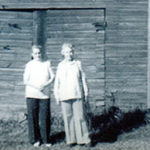You’ve got choices to make when you decide to tell your family story. Many of these choices should precede the writing of your story.
Your story will feature many people, places, and events. The potential for those is limitless, but it does not have to be overwhelming. If you sit down and consider certain choices before you begin, many of the other choices you’ll need to make become much easier.
The first choices you need to make
Before you even begin writing your family story, you’ll need to decide what you want to tell. What made you decide to write this story in the first place? What is the theme or story arc or lesson learned that you thought was worth sharing with your family or the world?
In my case, I knew I wanted to create the kind of stories that i like to read.
I don’t read for great insights into the human condition. When I want those, I read technical articles—and I’ve done plenty of that throughout my career. I’ve always read novels for relaxation and enjoyment — a chance to get away from the technical world.
Also I enjoy writing fun interactions a.k.a “immediate scenes.” (I talk more about immediate scenes in Part 7.) I think it was the fun interactions between my mother and her sister Alice that made me think there was a story to tell.
But sometimes the interactions aren’t just about fun. The push/pull relationship between the two sisters was so obvious that it had to be a major part of the story.
So to decide what story you will tell, consider the kind of story you want to write, your strengths as a writer, and the relationships that you are most interested in sharing — for whatever reason.
Who’s the protagonist?
You’ll need to decide who you want to feature in your story. Who’s your protagonist, your hero? Stories can be told from more than one person’s viewpoint, but generally it’s good to stick to a single point-of-view character. That is, one person through whose eyes the story will unfold.
Of course you’ll write about many people, but they’ll all be presented as seen by your protagonist. You’ll tell only those things that your protagonist can see, hear, smell, taste, touch, and think.
Compelling events
You want to tell your family’s story in a more interesting way. To do that, you’ll need to choose compelling events. There were probably some events in your family history that grabbed your attention, that made you think there’s a story here that needs telling.
When I read about the sadness that permeated my mother’s family when her sibling died at Christmastime, I knew that story had to be detailed and expanded.
This was a good choice because it’s a dramatic event that would have an impact on any family. But it also reflects a tragedy that was impacting many families of that time period — The Spanish influenza pandemic.
Many cases of the flu turned into the pneumonia that that ultimately killed the person. Real people from my family history died of pneumonia. Pneumonia was a deadly disease of the time, one that killed many people, young and old alike.
When you consider which compelling events you will choose to include in your family story, keep in mind the larger theme or time period as well as the impact on your family story.
Secondary characters
In addition, there are probably some interesting people in your history that you would like to know better or introduce to others. Family members that you were inspired by, curious about, or want to know better.
It is good to incorporate several of these people into your story, but do not lose sight of who’s story you are telling. Bring these people to life through the eyes of your protagonist.
And be careful, the more secondary characters you have the harder it is for your reader to follow the story. Only pull in a new character when you think it enhanced your plot line.
Get to know your characters
To begin, you’ll want to discover all you can about each of your characters. Reflect on what you already know. Talk with family and friends to learn more.
Learn more by searching Ancestry.com or other genealogy websites. Gather all the facts that you can find. This is your source material. Your job as a writer is to pump life into it.
Once you’ve gathered these facts, it’s time to develop your characters. You’ll include family members you know or have heard about. But if you write your story as family fiction, you’ll want to create other characters, too.
Write a character sketch for each real or imagined person in your story.
Describe how they talked — the language they used. If they were professionals it will be different than language used in the factories and fields.
Describe their temperaments. Were they gregarious, silent, or funny? Did they speak in full sentences, clip their sentences, or contract their words? Were they cultured or homey in their language and actions?
Did they hold grudges or were they the forgiving type? Were they aggressive, quiet, domineering, overbearing, condescending, or sarcastic? Develop these personality traits and more.
You’re not done yet!
Also include their appearance in your character sketch.
How old were they? What did they look like? Were they tall, short, fat, large-boned, slight of build, or short legged? Did they smile or frown? Were they happy or dour most of the time? Tell about the way they dressed, too.
Who were their friends, their enemies? What foods did they like, dislike? Where did they eat — home or away? Where did they live? What did they do for entertainment?
Most importantly, what exciting, fun things did they do? What made you want to write about them?
Learn as much as you possibly can about the family members you feature, and then include all those interesting details in your story. Choose which characteristics you will want to include or reveal
Whether writing non-fiction or fiction, the more personal characteristics you describe, the more life you’ll breath into your narrative and the more interesting it’ll be to those who read it.
Choose your primary relationships
Throughout the O’Shaughnessy Chronicles, Ruby and Catherine’s relationship remains consistent and predictable — Ruby the assertive, dominant older sister; Catherine the dutiful, subservient younger one.
Your family story will also have many relationships and you must choose which ones to emphasize and develop.
If you want to write scenes and dialogue based on real-life family events, but don’t have as much information as you’d like about what family members actually said or did, you will have to fill in the holes with fiction.
But keep their language and actions consistent with their personalities as you know them. The thorough character sketch that you create will help you to do this in a way that is believable and rings true.
Not all the relationships are in the past
Don’t ever use your story as a vehicle to get even for past hurts. You can choose what to write; be judicious about what you say. The people you write about in your stories may not be with us anymore, but their descendants and loved ones are. Be mindful of that fact.
Always inform your family when you’ve fictionalized your stories. Remember, it is also their story and naturally they can take things personally. If a family member takes offense about how you’ve described them, you may make an enemy forever.
Family members are likely to be your first readers. But if you have communicated to them what you have fictionalized and why, you can mitigate any ill feelings that might have arisen.
Next: Write Your Family Story – Part 7: Immediate Scenes
Start at the top: Write Your Family Story Series Introduction









